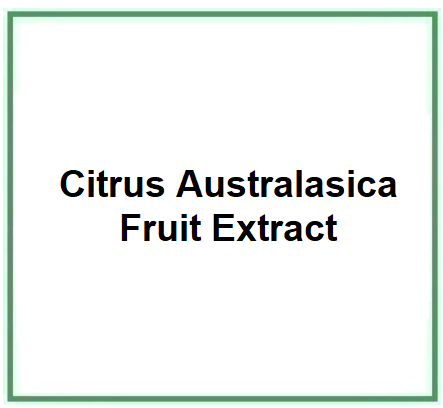Citrus Australasica Fruit Extract is a botanical ingredient obtained from the Citrus australasica F.Muell., tree. The fruit is an Australian citrus fruit called Finger Lime or Lemon Caviar because of the little bubbles in the pulp.
Like all trees of the Rutaceae family, the fruit is used industrially by food, cosmetic and pharmaceutical companies. It contains numerous components of interest to human health such as flavonoids, terpenes, linalool, vitamin C, folic acid, with antioxidant properties.
The name describes the structure of the molecule:
- Citrus Australasica is a citrus species, also known as "finger lime" or "caviar lime", native to Australia. The fruit is characterized by small juicy spheres inside, similar to caviar, and a unique flavor.
- Fruit. The term "fruit" refers to the edible part of a plant, typically containing seeds. Fruit extracts are rich in nutrients, vitamins, antioxidants, and other beneficial compounds, beneficial for skin and overall health.
- Extract. An extract is a concentrated substance obtained by treating a natural raw material (in this case, the fruit) to extract its soluble components. Fruit extracts are commonly used in cosmetics and skincare products for their moisturizing, nourishing, and protective properties.
Raw Materials Used in Production.
Citrus Australasica extract, also known as Caviar Lime or Finger Lime extract, comes from the fruit of the Citrus Australasica tree, native to Australia.
Step-by-step Summary of Industrial Production Process.
- Harvesting of Citrus Australasica fruits.
- Washing and cleaning of the fruits.
- Extraction of juice and pulp from the fruit.
- Filtration to remove solid residues.
- Concentration of the extract through evaporation.
- Stabilization to preserve the properties of the extract.
Form and Color.
The extract usually appears as a viscous liquid in pale yellow or slightly greenish color, depending on the concentration and extraction process.

What it is used for and where
Cosmetics
Skin conditioning agent - Humectant. Humectants are hygroscopic substances used to minimise water loss in the skin and to prevent it from drying out by facilitating faster and greater absorption of water into the stratum corneum of the epidermis. The epidermis is the most superficial of the three layers that make up the human skin (epidermis, dermis and hypodermis) and is the layer that maintains hydration in all three layers. In turn, the epidermis is composed of five layers: corneum, the most superficial, lucidum, granulosum, spinosum and basale. Humectants have the ability to retain in the stratum corneum the water they attract from the air and have the function of moisturising the skin. It is better to use them before emollients that are oil-based.
Antioxidant agent. Ingredient that counteracts oxidative stress and prevents cell damage. Free radicals, pathological inflammatory processes, reactive nitrogen species and reactive oxygen species are responsible for the ageing process and many diseases caused by oxidation.
Skin conditioning agent - Miscellaneous. This ingredient has the task of modifying the condition of the skin when it is damaged or dry by reducing its flakiness and restoring its elasticity.
CAS 1174331-57-7
Commercial Applications
Use in Cosmetics. This extract is commonly used in cosmetics for its nourishing and rejuvenating properties. It's rich in vitamins and antioxidants, which can help protect and rejuvenate the skin.
Anti-Aging Effects. Helps combat signs of aging due to its rich antioxidant content.
Skin Hydration. Offers hydration benefits, making the skin softer and more supple.
Potential Benefits for Hair. Can also be used in hair products to improve shine and strength.
Safety
Generally well-tolerated, but individuals with particularly sensitive skin or allergies to citrus might experience reactions.
![]() Citrus Australasica Fruit Extract
Citrus Australasica Fruit Extract 


